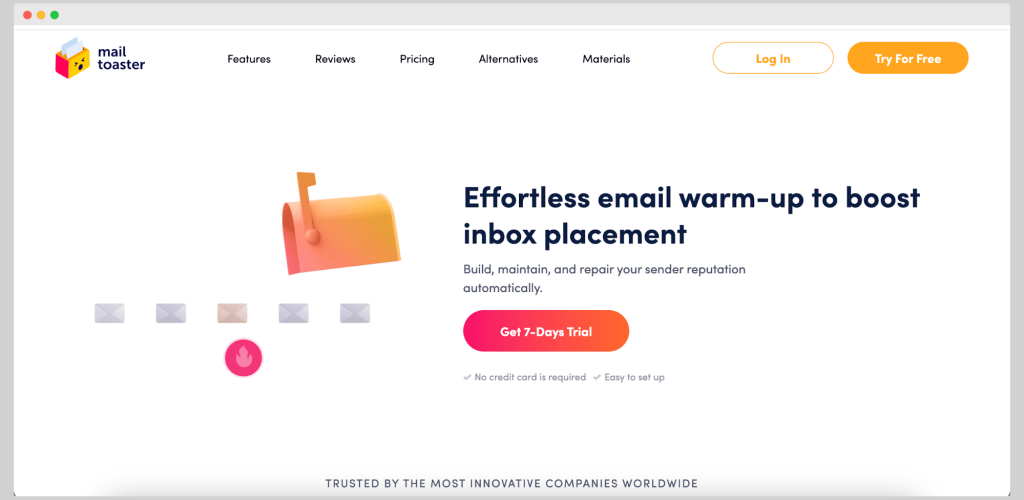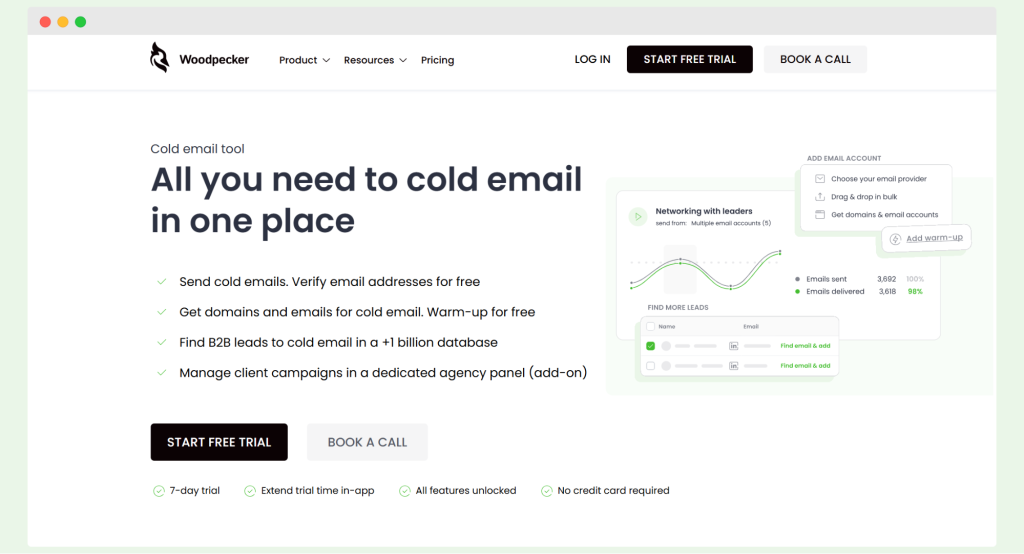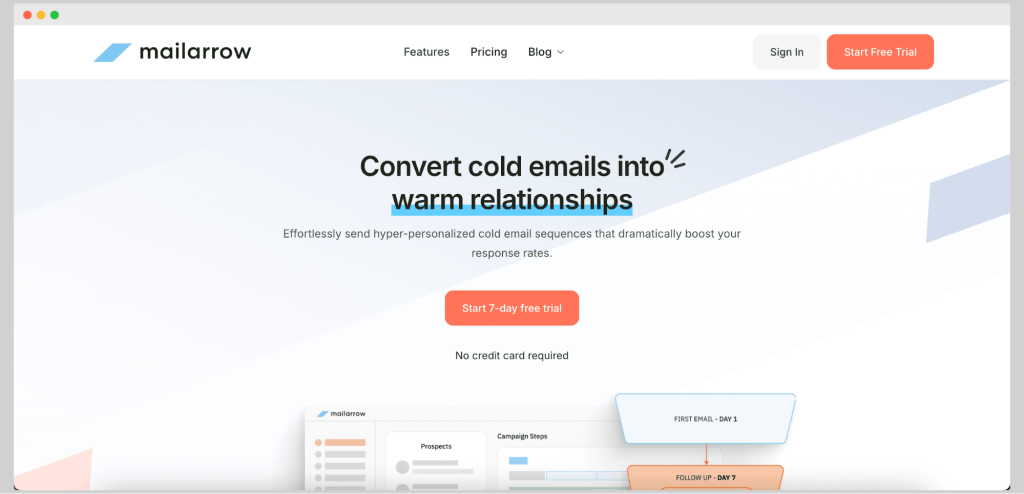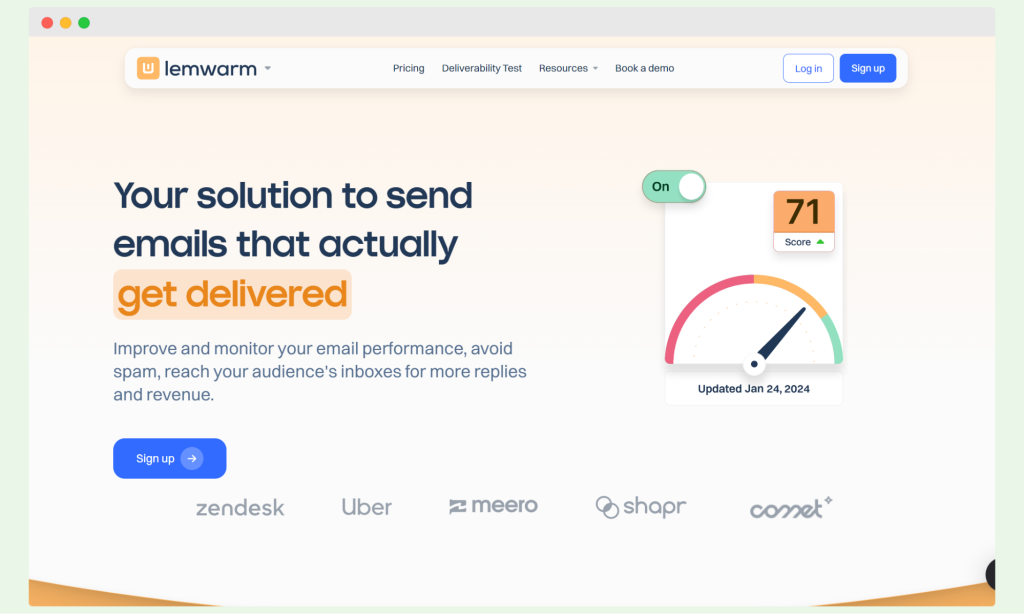You connect your account. You let the tool run. And… then what? No updates, no clear feedback, no idea if your emails are actually avoiding the spam folder. That’s the problem with some warm-up tools—they work in silence, and you’re left waiting.
Mailtoaster promises to fix your sender reputation and raise your deliverability. It has the basics covered, and it works with most email providers. But is it enough? And what are your other options if it’s not?
Let’s break it down.
What is Mailtoaster?

MailToaster is an email warm-up tool. It helps you get your inbox ready for outreach by sending and receiving messages through a trusted network of real inboxes. This regular activity builds your sender reputation over time, so your emails don’t end up in spam.
You start by connecting your email account – Gmail, Outlook, or any other provider. Then you configure warm-up settings based on your needs.
The tool sends auto-generated texts, interacts with them, and sorts warm-up emails into a separate folder. You can pick from multiple warm-up profiles and track your progress with detailed reports.
MailToaster is used by teams that want to run email campaigns, build, maintain, and repair their sender reputation without manual work.
Now let’s look at the key features.
Mailtoaster key features
- 100% automation – MailToaster runs the warm-up process for you, so you can build your sender reputation automatically without manual steps.
- Dedicated network of real inboxes – It sends and receives warm-up emails through a trusted network of real inboxes, making each action look natural.
- Available for GSuite, Outlook, and other providers – The tool works across major email providers, so you can start warming up your email no matter your setup.
- Multiple warm-up profiles – After a cold campaign, you can select a profile that aligns with your goal, such as domain (also known as IP warm) or reputation repair.
- Easily check DNS settings – MailToaster reviews SPF, DKIM, and DMARC to ensure your emails have the highest possible chance of arriving.
- Detailed deliverability reports – You get detailed reports to see how your inbox placement changes throughout the email warm-up.
Mailtoaster pricing
MailToaster runs on a flat rate – $29 per email account each month. It’s a pay-as-you-go plan, so you can pause or cancel anytime.
You can access Mailtoaster’s email warm-up tools, including multiple warm-up profiles, auto-generated texts, and inbox sorting to filter warm-up emails.
It’s used by teams running outbound campaigns who want to warm up to boost inbox placement without adding more tools or settings to manage.
What do customers say about email warm-up with Mailtoaster?
So far, not much. There are no reviews on G2, Capterra, TrustPilot, or anywhere else. Although MailToaster displays logos from well-known companies on its homepage, it appears that no one is sharing public feedback.
The homepage features a few short quotes, but they are not linked to full reviews or profiles. That makes it challenging to determine what real users say about email warm-up and how they are using the tool in practice.
If anyone has used MailToaster for multiple outbound campaigns and generally had success, they’re keeping it quiet – for now.
Top 3 Mailtoaster alternatives
If MailToaster isn’t quite your jam, these three tools might just warm your inboxes better (and cheaper!).
#1 Woodpecker

Woodpecker is a cold outreach platform that comes with a built-in email warm-up powered by Mailivery. The warm-up process runs in the background, helping you repair your sender reputation while you plan or send outreach campaigns.
It starts slow, with just a few emails per day, and gradually ramps up to 50 emails daily, keeping things natural and safe.
Woodpecker key features
- Automatic warm-up through Mailivery – Woodpecker connects with Mailivery to run the warm-up process for your email accounts without manual work.
- Gradual email ramp-up – Starts with a few emails per day and increases to 50, keeping your sending activity low-risk and realistic.
- Reply simulation and inbox sorting – Warm-up emails get real replies and are filtered into a separate folder, so they don’t mix with your real outreach.
- Timezone-based sending – Emails are sent Monday to Friday, aligned with your account’s time zone to mimic normal business hours.
- Free warm-up slots – Based on your plan, you get a set number of warm-ups for free, with extra slots priced transparently.
- Status tracking per inbox – Each account shows its warm-up status – Active, Inactive, or Stopped – so you always know what’s running.
- Pause or remove anytime – You can pause or entirely remove warm-ups from any inbox, and changes take effect immediately in your account.
- Inbox filtering with code IDs – Every warm-up email includes a code, so you can automatically sort and archive them.
- Email ramp-up controls – The Mailivery engine safely increases sending volume, helping you improve your inbox health over time.
Woodpecker considerations
Woodpecker keeps the process flexible. You can pause or remove the warm-up when needed, and everything happens inside the same dashboard where you run outreach.
One reviewer wrote, “Without the valuable advice and the Woodpecker tool, I would have undoubtedly seen my emails end up in spam.” (G2)
Another added, “We use Woodpecker daily and implement it for our clients. It just works.” (G2)
Even new users say it’s easy to manage: “The interface is clean and intuitive. I learned more about what went wrong with my domain setup in one demo call than in a year with another tool.” (G2)
Woodpecker pricing
Warm-up is included in paid plans. You get a certain number of free warm-up slots, based on your tier. Extra inboxes cost $5 each per month. Full outreach plans start at $20 per month.
Try it if you want cold email outreach and effortless email warm-up in one place. Many users who have tried Woodpecker say it’s reliable and easy to set up.
You can warm up with Woodpecker, run campaigns, and repair your sender reputation – all under one roof.
#2 Mailarrow

Mailarrow brings together cold outreach and email warm-up in one app. It gives you space to experiment, especially if you’re running campaigns from more than one mailbox.
The warm-up is AI-powered, and the setup feels lightweight, though not always the fastest. It’s best for those who want volume and don’t mind a few trade-offs.
Mailarrow key features
- Unlimited sending mailboxes let you run campaigns at scale without juggling limits.
- Smart inbox rotation spreads your emails across mailboxes to keep things steady.
- AI email warm-up runs in the background and adjusts based on performance.
- Email sequence builder helps you create custom follow-ups for each stage of your campaign.
- Campaign analytics show opens, replies, clicks, and other key numbers to track results.
Mailarrow Considerations
Some users report slow load times and mention that emails sometimes land in spam. One reviewer wrote, “Occasionally it’s laggy and the email will be seen in spam.” (G2) Another added, “Sometimes the email is found in spam, which needs to be improved.” (G2)
There’s not much public feedback to read through, so if you’re someone who likes comparing real experiences before choosing a tool, you might find this a bit limiting. On the other hand, having unlimited warm-up and mailboxes on all plans makes it appealing if you’re testing at a larger scale.
Mailarrow Pricing
Mailarrow offers three paid plans:
- Basic – $39/month for 2,000 prospects, 6,000 emails, unlimited warm-up, and unlimited mailboxes
- Professional – $59/month with 20,000 prospects, 60,000 emails, and AI personalization
- Growth – $99/month with 50,000 prospects, 150,000 emails, and all features unlocked
#3 Lemwarm

Lemwarm is the email warm-up tool from the team behind Lemlist. It was made to help your messages avoid spam folders and land where they’re supposed to – inside inboxes.
It’s a standalone tool focused just on warm-up and deliverability, with features built around tracking, team use, and performance reports.
Lemwarm key features
- Warm-up network sends and replies to emails between real accounts to build up your domain reputation.
- Deliverability tracking helps you monitor how your emails are doing across different inboxes and providers.
- Team-friendly setup makes it easier to manage multiple users under one workspace.
- Email health reports show trends and warnings to help keep your sending on track.
Lemwarm considerations
Lemwarm works well if you’re already using Lemlist, since it comes included in their outreach plans. As a separate tool, though, it’s more limited. A few users mentioned problems with API errors and email warm-ups going straight to spam or tabs. One review reads, “All our warm-up emails were going to the spam and categories section, which was really frustrating.” (G2)
Others noted restrictions like only being able to warm up one account per plan. And with no public reviews just for Lemwarm, it’s harder to judge how it performs across different use cases. Some users feel other tools offer more at a similar price. One person wrote, “Similar tools work better.” (G2)
Lemwarm pricing
Lemwarm starts at $29 per month, with three plans available. A free trial is offered on the lowest plan. If you already use Lemlist, you can get Lemwarm without extra cost.
Your inbox deserves more than a shot in the dark
It’s hard to trust a warm-up tool when you can’t see how well it works. No reviews, no clear results, and no public feedback means you’re flying blind. For a tool that’s meant to fix deliverability, that’s not ideal.
That’s why many switch to Woodpecker.
You don’t have to wonder what’s happening behind the scenes. You get real replies, inbox tracking, and spam recovery baked into the tool. You can see when the warm-up is running, when it pauses, and how your sender reputation is doing. No guesswork.
If you’re ready to stop hoping and start seeing inbox results, Woodpecker is worth trying. The warm-up feature comes built-in, and you can test it for free.
👉 Start your free trial at Woodpecker →

